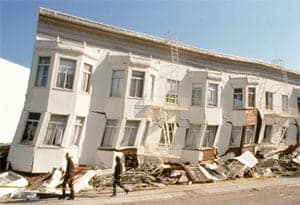Richter's Scale: Measure of an Earthquake, Measure of a Man
Susan Elizabeth Hough
2007 Princeton University Press
336pp £17.95/$27.95 hb

The earthquake that launched the career of the world’s most famous seismologist, Charles Richter, struck Long Beach near Los Angeles in 1933. With a magnitude of 6.4 on what would soon become known as the Richter scale, it killed 120 people and caused property damage estimated at $50m in depression-era dollars, including the collapse of several poorly constructed schools. Only the lateness of the hour – just before 6 p.m. – saved hundreds of schoolchildren from almost certain death.
One witness was Albert Einstein, then a visiting professor at the California Institute of Technology in Pasadena about 30 miles from Long Beach. Einstein was walking across the campus after a seminar, chatting about earthquakes with Caltech’s leading seismologist, fellow German-Jewish refugee Beno Gutenberg. Another professor approached them and asked what they thought of the earthquake. “What earthquake?” came the reply. Engrossed in their conversation, the two scientists had not noticed tree branches and power lines swaying around them. When Gutenberg reached the Seismological Laboratory soon afterwards, he told the story to his younger colleague Richter with considerable amusement. On returning home late that night, Richter’s wife told him that their cat had “spat on the floor because it wasn’t behaving properly”.
Susan Elizabeth Hough’s biography of Richter (1900–1985) is full of such engaging anecdotes. An experienced seismologist herself, based at the US Geological Survey (USGS) in Pasadena, Hough did not know her subject personally, but she has interviewed virtually everyone who did. More importantly, she had access to the extraordinarily frank papers that the intensely private Richter deposited in the archives at Caltech before his death – presumably in the expectation that one day someone would write his story.
The resulting book – the first biography of Richter – is a major achievement, albeit with some serious faults. It will intrigue anyone interested in earthquakes, and it also offers some penetrating insights into southern Californian academic life. There was, it turns out, much more to Richter than his earthquake magnitude scale and a classic seismology textbook – if not quite as much more as Hough claims.
Richter used the new scale to measure earthquakes from 1932, but he published it only in 1935 – the date usually given for its inception – in a long paper in the leading US seismological journal with himself as sole author. As with many breakthroughs, its paternity soon became controversial. At the time, Richter was working closely with Gutenberg, who suggested that the scale should be logarithmic. A second Caltech colleague, Harry Wood, proposed the term “magnitude” in order to distinguish the concept from the long-familiar measurement of earthquake “intensity” based on the amount of damage caused to surface structures near the epicentre. Meanwhile, a 1931 paper by Kiyoo Wadati in Japan indicated how to correct for the distance of a seismometer from the epicentre.
Richter freely acknowledged these contributions, but nevertheless he “felt a unique sense of ownership about his scale”, says Hough, given his enormous investment of effort in measuring earthquakes and calculating their magnitudes. She supports Richter’s claim, but discusses fully and fairly the views of many seismologists that the correct name should be the “Gutenberg–Richter scale”. The issue remains sensitive, with the Encyclopaedia Britannica attributing the “Richter” scale to both men.
Moreover, as the author clearly explains, Richter’s original scale is no longer used by seismologists because it was explicitly based on a certain type of seismometer (the Wood–Anderson). This design has now been superseded by seismometers that can respond to the very lowest tones generated by earthquakes, which are a particular feature of the largest events. That said, “every magnitude scale used today can trace its lineage directly to Charles Richter’s scale”. It would have been better, in Hough’s view, to have adopted the “modified Richter scale” as an umbrella term, and she reasonably forecasts that “Richter magnitude” will increasingly be replaced by just “magnitude” in the public reporting of earthquakes.
Earthquake prediction is the subject of an excellent chapter in the book. During the 1970s there was overweening confidence in scientific prediction, and Richter was reluctantly cajoled into commenting on the possibilities. Generally blunt in his assessments, he stated: “Only fools and charlatans predict earthquakes.” In a textbook published in 1958 he offers a vivid analogy for prediction: “One may compare it to the situation of a man who is bending a board across his knee and attempts to determine in advance just where and when the cracks will appear.” Hough admits that seismologists are no further forward with earthquake prediction now than in the 1970s, but adds that a successful method of prediction may be possible in the future.
The seismology in the book is handled with great assurance, though there is scarcely any attempt to provide the basic information that non-seismologists will require. But the personal aspects of the story are not so successful. Richter was a complex, neurotic loner: the product of a dysfunctional family who remembered only one meeting with his father and used his divorced mother’s surname; who possibly had an incestuous affair with his sister; and who certainly did not love his wife for long periods of their marriage. He was a keen nudist; a solitary mountain hiker; a gifted linguist who seldom left California; and, above all, an obsessive but unfocused writer, who slipped inadvertently into seismology from quantum physics while always feeling that his true vocation was poetry.
In some ways, Richter is a dream subject, provided that the biographer has the literary skill to mould order out of such messy inner conflict. Hough shows flashes of style, as when she writes of Richter as “a man whose brain, while extraordinarily nimble, was also extraordinarily wired”, but too much of her prose is poorly structured, leaden, repetitive and burdened with political correctness. With sympathetic but severe editing, Richter’s Scale could have been consistently enjoyable as well as deeply researched.



